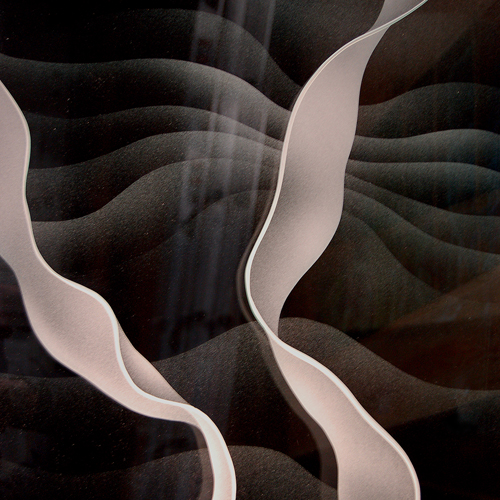Between Glass and Stone
May 21st, 2015 by Ron Branch
 Relief carving by Ron Branch circa 1989 ~ I’d like to do a series of these soon. This is a small piece of flagstone, approximately 8″ x 12″. It has hand crafted mounting hardware by Bill Branch (my Dad).
Relief carving by Ron Branch circa 1989 ~ I’d like to do a series of these soon. This is a small piece of flagstone, approximately 8″ x 12″. It has hand crafted mounting hardware by Bill Branch (my Dad).
Between glass and stone I feel stone is the more forgiving medium to work with. As a material, float glass is predictable, as in there are no hidden surprises. As a transparent canvas it is unique, with its distinctly beautiful qualities, but there is no variance from piece to piece… and so it quickly becomes all about the etching.
With stone however, you enter the unknown every time. Oddly though, this is not a source of anxiety. Instead, a great deal of the pressure is off. In those rare occasions that something bad is coming, like a severe crack, or a pocket of nothingness, you don’t see it until it arrives. Blaming yourself for the issue is useless since you really had no way of foreseeing it. Blaming the stone, well… that would just be absurd.
So for me there is a self granted state of acceptance. Besides, most of the “surprises” are often what I like best about the finished piece. There really IS therefore, a strong feeling of interaction, a kind of partnership with the material. By virtue of it’s unpredictable variances, it participates – lending its uniqueness to the art.
Does it sound strange that the more unpredictable material would be less stressful to work with? Think of the difference between what a singer songwriter feels when they perform solo, and when they have others playing with them. This also compares well to say that it doesn’t mean that just because playing solo is more stressful, that the performer doesn’t want to do it anyway, despite that it is not the more relaxing choice.
The analogy easily extends to also cover the subject of collaborating with other glass artists. I so much prefer working with others rather than solo, that it is a large part of my business model for the studio. I think networking with other glass artists and studios that like working this way also, adds more variety into our works, and provides hidden opportunities for unexpected new developments. These interactions have caused some of my favorite leaps in technique.
 Working with designers from other mediums is an even more dynamic process. I’d say my favorite of these was working with painter Marlene Bauer on the library jobs in 2010. It inspired me to try things I may not have thought of otherwise. The resulting textures affected permanently many of the ways I etch today, which continue to develop… and to be similarly affected by subsequent interactions with other artists, designers and of course to be fair, every client.
Working with designers from other mediums is an even more dynamic process. I’d say my favorite of these was working with painter Marlene Bauer on the library jobs in 2010. It inspired me to try things I may not have thought of otherwise. The resulting textures affected permanently many of the ways I etch today, which continue to develop… and to be similarly affected by subsequent interactions with other artists, designers and of course to be fair, every client.
Overall both glass and stone are relatively unforgiving. There is no erasing in glass etching, and you can’t uncarve a stone. Part of being a sandblaster is all about learning to handle stress, with balance, acceptance, and keeping things in perspective.
Sweating over the details of an etching that you can easily ruin in the blink of an eye… while it isn’t exactly bungee jumping, there is a genuine adrenalin rush occurring just the same.
Admittedly it is… fun, especially when in the end it turns out to have been worth the effort, but too much of that kind of fun can wear a person down. That’s why I’d say by comparison, for me there IS actual relief in carving stone. A bit of corrective therapy perhaps.
- No Comments »
- Posted in Carved Stone, Etched Glass





































